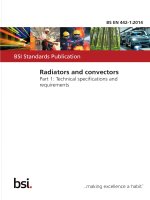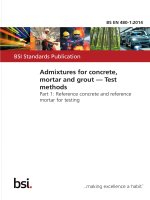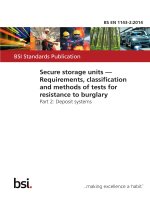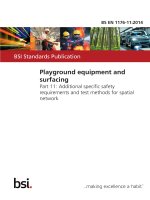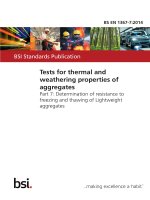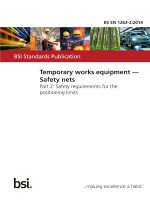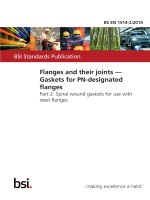Bsi bs en 62386 103 2014
Bạn đang xem bản rút gọn của tài liệu. Xem và tải ngay bản đầy đủ của tài liệu tại đây (2.68 MB, 220 trang )
BS EN 62386-103:2014
BSI Standards Publication
Digital addressable
lighting interface
Part 103: General requirements —
Control devices
BRITISH STANDARD
BS EN 62386-103:2014
National foreword
This British Standard is the UK implementation of EN 62386-103:2014. It is
identical to IEC 62386-103:2014.
The UK participation in its preparation was entrusted by Technical
Committee CPL/34, Lamps and Related Equipment, to Subcommittee
CPL/34/3, Auxiliaries for lamps.
A list of organizations represented on this committee can be obtained on
request to its secretary.
This publication does not purport to include all the necessary provisions of
a contract. Users are responsible for its correct application.
© The British Standards Institution 2015.
Published by BSI Standards Limited 2015
ISBN 978 0 580 62956 3
ICS 29.140; 29.140.50
Compliance with a British Standard cannot confer immunity from
legal obligations.
This British Standard was published under the authority of the
Standards Policy and Strategy Committee on 31 January 2015.
Amendments/corrigenda issued since publication
Date
Text affected
BS EN 62386-103:2014
EUROPEAN STANDARD
EN 62386-103
NORME EUROPÉENNE
EUROPÄISCHE NORM
December 2014
ICS 29.140; 29.140.50
English Version
Digital addressable lighting interface Part 103: General requirements - Control devices
(IEC 62386-103:2014)
Interface d'éclairage adressable numérique Partie 103: Exigences générales - Dispositifs de commande
(CEI 62386-103:2014)
Digital adressierbare Schnittstelle für die Beleuchtung Teil 103: Allgemeine Anforderungen - Steuergeräte
(IEC 62386-103:2014)
This European Standard was approved by CENELEC on 2014-12-12. CENELEC members are bound to comply with the CEN/CENELEC
Internal Regulations which stipulate the conditions for giving this European Standard the status of a national standard without any alteration.
Up-to-date lists and bibliographical references concerning such national standards may be obtained on application to the CEN-CENELEC
Management Centre or to any CENELEC member.
This European Standard exists in three official versions (English, French, German). A version in any other language made by translation
under the responsibility of a CENELEC member into its own language and notified to the CEN-CENELEC Management Centre has the
same status as the official versions.
CENELEC members are the national electrotechnical committees of Austria, Belgium, Bulgaria, Croatia, Cyprus, the Czech Republic,
Denmark, Estonia, Finland, Former Yugoslav Republic of Macedonia, France, Germany, Greece, Hungary, Iceland, Ireland, Italy, Latvia,
Lithuania, Luxembourg, Malta, the Netherlands, Norway, Poland, Portugal, Romania, Slovakia, Slovenia, Spain, Sweden, Switzerland,
Turkey and the United Kingdom.
European Committee for Electrotechnical Standardization
Comité Européen de Normalisation Electrotechnique
Europäisches Komitee für Elektrotechnische Normung
CEN-CENELEC Management Centre: Avenue Marnix 17, B-1000 Brussels
© 2014 CENELEC All rights of exploitation in any form and by any means reserved worldwide for CENELEC Members.
Ref. No. EN 62386-103:2014 E
BS EN 62386-103:2014
EN 62386-103:2014
-2-
Foreword
The text of document 34C/1100/FDIS, future edition 1 of IEC 62386-103, prepared by
SC 34C "Auxiliaries for lamps" of IEC/TC 34 "Lamps and related equipment" was submitted to the
IEC-CENELEC parallel vote and approved by CENELEC as EN 62386-103:2014.
The following dates are fixed:
•
latest date by which the document has to be
implemented at national level by
publication of an identical national
standard or by endorsement
(dop)
2015-09-12
•
latest date by which the national
standards conflicting with the
document have to be withdrawn
(dow)
2017-12-12
Attention is drawn to the possibility that some of the elements of this document may be the subject of
patent rights. CENELEC [and/or CEN] shall not be held responsible for identifying any or all such
patent rights.
Endorsement notice
The text of the International Standard IEC 62386-103:2014 was approved by CENELEC as a
European Standard without any modification.
In the official version, for Bibliography, the following notes have to be added for the standards indicated:
CISPR 15
NOTE
Harmonized as EN 55015.
IEC 60598-1
NOTE
Harmonized as EN 60598-1.
IEC 60669-2-1
NOTE
Harmonized as EN 60669-2-1.
IEC 60921
NOTE
Harmonized as EN 60921.
IEC 60923
NOTE
Harmonized as EN 60923.
IEC 60929
NOTE
Harmonized as EN 60929.
IEC 61347-1
NOTE
Harmonized as EN 61347-1.
IEC 61347-2-3
NOTE
Harmonized as EN 61347-2-3.
IEC 61547
NOTE
Harmonized as EN 61547.
IEC 62034
NOTE
Harmonized as EN 62034.
BS EN 62386-103:2014
EN 62386-103:2014
-3-
Annex ZA
(normative)
Normative references to international publications
with their corresponding European publications
The following documents, in whole or in part, are normatively referenced in this document and are
indispensable for its application. For dated references, only the edition cited applies. For undated
references, the latest edition of the referenced document (including any amendments) applies.
NOTE 1 When an International Publication has been modified by common modifications, indicated by (mod), the relevant
EN/HD applies.
NOTE 2 Up-to-date information on the latest versions of the European Standards listed in this annex is available here:
www.cenelec.eu
Publication
Year
Title
EN/HD
IEC 62386-101
2014
Digital addressable lighting interface EN 62386-101
Part 101: General requirements - System
Components
2014
IEC 62386-102
2014
Digital addressable lighting interface Part 102: General requirements - Control
gear
2014
EN 62386-102
Year
–2–
BS EN 62386-103:2014
IEC 62386-103:2014 © IEC 2014
CONTENTS
INTRODUCTION ................................................................................................................... 13
1
Scope ............................................................................................................................ 15
2
Normative references .................................................................................................... 15
3
Terms and definitions .................................................................................................... 15
4
General ......................................................................................................................... 18
4.1
General ................................................................................................................. 18
4.2
Version number .................................................................................................... 18
5
Electrical specification ................................................................................................... 18
6
Interface power supply .................................................................................................. 18
7
Transmission protocol structure ..................................................................................... 18
7.1
General ................................................................................................................. 18
7.2
24 bit forward frame encoding ............................................................................... 19
7.2.1
Frame format for instructions and queries ...................................................... 19
7.2.2
Frame format for event messages.................................................................. 20
Timing ........................................................................................................................... 21
8
9
Method of operation ....................................................................................................... 21
9.1
9.2
9.2.1
9.2.2
9.2.3
9.3
9.4
9.4.1
9.4.2
9.4.3
9.4.4
9.4.5
9.5
9.5.1
9.5.2
9.5.3
9.5.4
9.6
9.6.1
9.6.2
9.6.3
9.6.4
9.7
9.7.1
9.7.2
9.7.3
9.7.4
9.8
General ................................................................................................................. 21
Application controller ............................................................................................ 21
General ......................................................................................................... 21
Single-master application controller ............................................................... 22
Multi-master application controller ................................................................. 22
Input device .......................................................................................................... 22
Instances of input devices ..................................................................................... 23
General ......................................................................................................... 23
Instance number ............................................................................................ 23
Instance type ................................................................................................. 23
Feature type .................................................................................................. 23
Instance groups ............................................................................................. 24
Commands ........................................................................................................... 24
General ......................................................................................................... 24
Device commands ......................................................................................... 24
Instance commands ....................................................................................... 25
Feature commands ........................................................................................ 25
Event messages ................................................................................................... 25
Response to event messages ........................................................................ 25
Device power cycle event .............................................................................. 25
Input notification event .................................................................................. 25
Event message filter ...................................................................................... 26
Input signal and input value .................................................................................. 27
General ......................................................................................................... 27
Input resolution .............................................................................................. 27
Getting the input value ................................................................................... 27
Notification of changes .................................................................................. 28
System failure ....................................................................................................... 28
BS EN 62386-103:2014
IEC 62386-103:2014 © IEC 2014
–3–
9.9
Operating a control device .................................................................................... 29
9.9.1
Enable/disable the application controller ........................................................ 29
9.9.2
Enable/disable event messages ..................................................................... 29
9.9.3
Quiescent mode ............................................................................................ 29
9.9.4
Modes of operation ........................................................................................ 30
9.10 Memory banks ...................................................................................................... 30
9.10.1
General ......................................................................................................... 30
9.10.2
Memory map .................................................................................................. 31
9.10.3
Selecting a memory bank location ................................................................. 31
9.10.4
Memory bank reading .................................................................................... 32
9.10.5
Memory bank writing ...................................................................................... 32
9.10.6
Memory bank 0 .............................................................................................. 33
9.10.7
Memory bank 1 .............................................................................................. 35
9.10.8
Manufacturer specific memory banks ............................................................. 37
9.10.9
Reserved memory banks ............................................................................... 37
9.11 Reset .................................................................................................................... 37
9.11.1
Reset operation ............................................................................................. 37
9.11.2
Reset memory bank operation ....................................................................... 37
9.12 Power on behaviour .............................................................................................. 37
9.12.1
Power on ....................................................................................................... 37
9.12.2
Power cycle notification ................................................................................. 38
9.13 Priority use ........................................................................................................... 38
9.13.1
General ......................................................................................................... 38
9.13.2
Priority of input notifications .......................................................................... 38
9.14 Assigning short addresses .................................................................................... 39
9.14.1
General ......................................................................................................... 39
9.14.2
Random address allocation ............................................................................ 39
9.14.3
Identification of a device ................................................................................ 39
9.15 Exception handling ............................................................................................... 40
9.16 Device capabilities and status information ............................................................ 40
9.16.1
Device capabilities ......................................................................................... 40
9.16.2
Device status ................................................................................................. 40
9.16.3
Instance status .............................................................................................. 41
9.17 Non-volatile memory ............................................................................................. 41
10 Declaration of variables ................................................................................................. 42
11
Definition of commands ................................................................................................. 43
11.1 General ................................................................................................................. 43
11.2 Overview sheets ................................................................................................... 43
11.3 Event messages ................................................................................................... 48
11.3.1
INPUT NOTIFICATION (device/instance, event) ................................................ 48
11.3.2
POWER NOTIFICATION (device) ................................................................... 48
11.4 Device control instructions .................................................................................... 48
11.4.1
General ......................................................................................................... 48
11.4.2
IDENTIFY DEVICE ........................................................................................ 48
11.4.3
RESET POWER CYCLE SEEN ...................................................................... 49
11.5 Device configuration instructions........................................................................... 49
11.5.1
General ......................................................................................................... 49
11.5.2
RESET .......................................................................................................... 49
11.5.3
RESET MEMORY BANK (DTR0) .................................................................... 49
–4–
BS EN 62386-103:2014
IEC 62386-103:2014 © IEC 2014
11.5.4
SET SHORT ADDRESS (DTR0) ..................................................................... 49
11.5.5
ENABLE WRITE MEMORY ............................................................................ 49
11.5.6
ENABLE APPLICATION CONTROLLER ........................................................ 50
11.5.7
DISABLE APPLICATION CONTROLLER ....................................................... 50
11.5.8
SET OPERATING MODE (DTR0) ................................................................... 50
11.5.9
ADD TO DEVICE GROUPS 0-15 (DTR2:DTR1) .............................................. 50
11.5.10 ADD TO DEVICE GROUPS 16-31 ( DTR2:DTR1 ) .......................................... 50
11.5.11 REMOVE FROM DEVICE GROUPS 0-15 (DTR2:DTR1) .................................. 50
11.5.12 REMOVE FROM DEVICE GROUPS 16-31 (DTR2:DTR1) ................................ 50
11.5.13 START QUIESCENT MODE .......................................................................... 50
11.5.14 STOP QUIESCENT MODE ............................................................................ 50
11.5.15 ENABLE POWER CYCLE NOTIFICATION ..................................................... 51
11.5.16 DISABLE POWER CYCLE NOTIFICATION .................................................... 51
11.5.17 SAVE PERSISTENT VARIABLES .................................................................. 51
11.6 Device queries ...................................................................................................... 51
11.6.1
General ......................................................................................................... 51
11.6.2
QUERY DEVICE CAPABILITIES .................................................................... 51
11.6.3
QUERY DEVICE STATUS ............................................................................. 51
11.6.4
QUERY APPLICATION CONTROLLER ERROR ............................................ 52
11.6.5
QUERY INPUT DEVICE ERROR ................................................................... 52
11.6.6
QUERY MISSING SHORT ADDRESS ............................................................ 52
11.6.7
QUERY VERSION NUMBER .......................................................................... 52
11.6.8
QUERY CONTENT DTR0 .............................................................................. 52
11.6.9
QUERY NUMBER OF INSTANCES ................................................................ 52
11.6.10 QUERY CONTENT DTR1 .............................................................................. 52
11.6.11 QUERY CONTENT DTR2 .............................................................................. 52
11.6.12 QUERY RANDOM ADDRESS (H) .................................................................. 53
11.6.13 QUERY RANDOM ADDRESS (M) .................................................................. 53
11.6.14 QUERY RANDOM ADDRESS (L) ................................................................... 53
11.6.15 READ MEMORY LOCATION (DTR1, DTR0) .................................................... 53
11.6.16 QUERY APPLICATION CONTROL ENABLED ............................................... 53
11.6.17 QUERY OPERATING MODE ......................................................................... 53
11.6.18 QUERY MANUFACTURER SPECIFIC MODE ................................................ 53
11.6.19 QUERY QUIESCENT MODE .......................................................................... 53
11.6.20 QUERY DEVICE GROUPS 0-7 ...................................................................... 53
11.6.21 QUERY DEVICE GROUPS 8-15 .................................................................... 54
11.6.22 QUERY DEVICE GROUPS 16-23 .................................................................. 54
11.6.23 QUERY DEVICE GROUPS 24-31 .................................................................. 54
11.6.24 QUERY POWER CYCLE NOTIFICATION ...................................................... 54
11.6.25 QUERY EXTENDED VERSION NUMBER(DTR0) ........................................... 54
11.6.26 QUERY RESET STATE ................................................................................. 54
11.7 Instance control instructions ................................................................................. 54
11.8 Instance configuration instructions ........................................................................ 54
11.8.1
General ......................................................................................................... 54
11.8.2
ENABLE INSTANCE ...................................................................................... 55
11.8.3
DISABLE INSTANCE ..................................................................................... 55
11.8.4
SET PRIMARY INSTANCE GROUP (DTR0) ................................................... 55
11.8.5
SET INSTANCE GROUP 1 (DTR0) ................................................................. 55
11.8.6
SET INSTANCE GROUP 2 (DTR0) ................................................................. 55
BS EN 62386-103:2014
IEC 62386-103:2014 © IEC 2014
–5–
11.8.7
SET EVENT SCHEME (DTR0) ........................................................................ 55
11.8.8
SET EVENT PRIORITY (DTR0) ...................................................................... 56
11.8.9
SET EVENT FILTER (DTR2, DTR1, DTR0) ...................................................... 56
11.9 Instance queries ................................................................................................... 56
11.9.1
General ......................................................................................................... 56
11.9.2
QUERY INSTANCE TYPE ............................................................................. 56
11.9.3
QUERY RESOLUTION .................................................................................. 56
11.9.4
QUERY INSTANCE ERROR .......................................................................... 56
11.9.5
QUERY INSTANCE STATUS ......................................................................... 56
11.9.6
QUERY INSTANCE ENABLED ...................................................................... 57
11.9.7
QUERY PRIMARY INSTANCE GROUP ......................................................... 57
11.9.8
QUERY INSTANCE GROUP 1 ....................................................................... 57
11.9.9
QUERY INSTANCE GROUP 2 ....................................................................... 57
11.9.10 QUERY EVENT SCHEME .............................................................................. 57
11.9.11 QUERY INPUT VALUE .................................................................................. 57
11.9.12 QUERY INPUT VALUE LATCH ...................................................................... 57
11.9.13 QUERY EVENT PRIORITY ............................................................................ 57
11.9.14 QUERY FEATURE TYPE ............................................................................... 58
11.9.15 QUERY NEXT FEATURE TYPE ..................................................................... 58
11.9.16 QUERY EVENT FILTER 0-7 .......................................................................... 58
11.9.17 QUERY EVENT FILTER 8-15 ........................................................................ 58
11.9.18 QUERY EVENT FILTER 16-23....................................................................... 58
11.10 Special commands ................................................................................................ 58
11.10.1 General ......................................................................................................... 58
11.10.2 TERMINATE .................................................................................................. 58
11.10.3 INITIALISE (device) ........................................................................................ 59
11.10.4 RANDOMISE ................................................................................................. 59
11.10.5 COMPARE .................................................................................................... 59
11.10.6 WITHDRAW ................................................................................................... 59
11.10.7 SEARCHADDRH (data) .................................................................................. 60
11.10.8 SEARCHADDRM (data) ................................................................................. 60
11.10.9 SEARCHADDRL (data) .................................................................................. 60
11.10.10 PROGRAM SHORT ADDRESS (data) ............................................................ 60
11.10.11 VERIFY SHORT ADDRESS (data) ................................................................. 60
11.10.12 QUERY SHORT ADDRESS ........................................................................... 61
11.10.13 WRITE MEMORY LOCATION (DTR1, DTR0, data) .......................................... 61
11.10.14 WRITE MEMORY LOCATION – NO REPLY (DTR1, DTR0, data) ..................... 61
11.10.15 DTR0 (data) ................................................................................................... 61
11.10.16 DTR1 (data) ................................................................................................... 62
11.10.17 DTR2 (data) ................................................................................................... 62
11.10.18 DIRECT WRITE MEMORY (DTR1, offset, data) ............................................... 62
11.10.19 DTR1:DTR0 (data1, data0) .............................................................................. 62
11.10.20 DTR2:DTR1 (data2, data1) .............................................................................. 62
11.10.21 SEND TESTFRAME (data) ............................................................................. 62
12 Test procedures ............................................................................................................ 63
12.1 General notes on test............................................................................................ 63
12.1.1
General ......................................................................................................... 63
12.1.2
Test execution ............................................................................................... 63
12.1.3
Data transmission .......................................................................................... 64
–6–
BS EN 62386-103:2014
IEC 62386-103:2014 © IEC 2014
12.1.4
Test setup ..................................................................................................... 64
12.1.5
Test output .................................................................................................... 64
12.1.6
Test notation ................................................................................................. 65
12.1.7
Test execution limitations .............................................................................. 66
12.1.8
Test results ................................................................................................... 66
12.1.9
Exception handling ........................................................................................ 66
12.1.10 Unexpected answer ....................................................................................... 66
12.2 Preamble .............................................................................................................. 68
12.2.1
Test preamble ............................................................................................... 68
12.3 Physical operational parameters ........................................................................... 79
12.3.1
Polarity test ................................................................................................... 79
12.3.2
Maximum and minimum system voltage ......................................................... 80
12.3.3
Overvoltage protection test ............................................................................ 80
12.3.4
Current rating test.......................................................................................... 81
12.3.5
Transmitter voltages ...................................................................................... 83
12.3.6
Transmitter rising and falling edges ............................................................... 84
12.3.7
Transmitter bit timing ..................................................................................... 86
12.3.8
Transmitter frame timing ................................................................................ 88
12.3.9
Receiver start-up behavior ............................................................................. 89
12.3.10 Receiver threshold ......................................................................................... 90
12.3.11 Receiver bit timing ......................................................................................... 91
12.3.12 Extended receiver bit timing .......................................................................... 95
12.3.13 Receiver forward frame violation.................................................................... 97
12.3.14 Receiver settling timing ................................................................................. 97
12.3.15 Receiver frame timing FF-FF send twice ........................................................ 98
12.3.16 Transmitter collision avoidance by priority ................................................... 100
12.3.17 Transmitter collision detection for truncated idle phase ................................ 101
12.3.18 Transmitter collision detection for extended active phase ............................ 104
12.4 Device configuration instructions......................................................................... 107
12.4.1
RESET deviceGroups .................................................................................. 107
12.4.2
RESET quiescentMode ................................................................................ 108
12.4.3
RESET instance groups ............................................................................... 109
12.4.4
RESET event filter ....................................................................................... 110
12.4.5
RESET event scheme .................................................................................. 111
12.4.6
RESET: timeout / command in-between ....................................................... 112
12.4.7
Send twice timeout (device) ......................................................................... 114
12.4.8
Send twice timeout (instance) ...................................................................... 117
12.4.9
Commands in-between (device) ................................................................... 119
12.4.10 Commands in-between (instance) ................................................................ 122
12.4.11 SAVE PERSISTENT VARIABLES ................................................................ 125
12.4.12 SET OPERATING MODE ............................................................................. 125
12.4.13 Device Disable/Enable Application Controller .............................................. 126
12.4.14 Multi Master Control Device PING ............................................................... 127
12.4.15 Quiescent Mode .......................................................................................... 128
12.4.16 Device power cycle notification .................................................................... 129
12.4.17 SET SHORT ADDRESS ............................................................................... 130
12.4.18 Reset/Power-on values (device) .................................................................. 131
12.4.19 Reset/Power-on values (instance) ............................................................... 133
12.4.20 DTR0 / DTR1 / DTR2 ................................................................................... 134
BS EN 62386-103:2014
IEC 62386-103:2014 © IEC 2014
–7–
12.4.21 DTR1:DTR0 and DTR2:DTR1 ...................................................................... 135
12.4.22 Device Groups ............................................................................................. 136
12.5 Device queries .................................................................................................... 137
12.5.1
Device query capabilities ............................................................................. 137
12.5.2
QUERY VERSION NUMBER ........................................................................ 137
12.5.3
Device power cycle seen ............................................................................. 138
12.5.4
Input device error ........................................................................................ 138
12.6 Device Memory banks ......................................................................................... 139
12.6.1
READ MEMORY LOCATION on Memory Bank 0 .......................................... 139
12.6.2
READ MEMORY LOCATION on Memory Bank 1 .......................................... 144
12.6.3
READ MEMORY LOCATION on other Memory Banks .................................. 146
12.6.4
Memory bank writing .................................................................................... 148
12.6.5
ENABLE WRITE MEMORY: writeEnableState .............................................. 153
12.6.6
ENABLE WRITE MEMORY: timeout / command in-between ......................... 155
12.6.7
RESET MEMORY BANK: timeout / command in-between ............................ 156
12.6.8
RESET MEMORY BANK .............................................................................. 159
12.7 Device Special commands .................................................................................. 160
12.7.1
INITIALISE – timer ....................................................................................... 160
12.7.2
TERMINATE ................................................................................................ 161
12.7.3
INITIALISE - device addressing ................................................................... 162
12.7.4
RANDOMISE ............................................................................................... 163
12.7.5
COMPARE .................................................................................................. 163
12.7.6
WITHDRAW ................................................................................................. 165
12.7.7
SEARCHADDRH / SEARCHADDRM / SEARCHADDRL ............................... 166
12.7.8
PROGRAM SHORT ADDRESS .................................................................... 167
12.7.9
VERIFY SHORT ADDRESS ......................................................................... 169
12.7.10 QUERY SHORT ADDRESS ......................................................................... 170
12.7.11 IDENTIFY DEVICE ...................................................................................... 172
12.8 Logical unit cross contamination ......................................................................... 174
12.8.1
DTR0 ........................................................................................................... 174
12.8.2
NVM variables ............................................................................................. 174
12.8.3
Random address generation ........................................................................ 175
12.8.4
Addressing 1 ............................................................................................... 176
12.8.5
Addressing 2 ............................................................................................... 177
12.8.6
Addressing 3 ............................................................................................... 179
12.9 Instance addressing ............................................................................................ 180
12.9.1
Instance Type Addressing ........................................................................... 180
12.9.2
Instance Primary Group ............................................................................... 181
12.9.3
Instance Group 2 ......................................................................................... 182
12.9.4
Instance Group 1 ......................................................................................... 184
12.9.5
Instance Group Combinations ...................................................................... 185
12.9.6
Multiple Instances Answer ........................................................................... 187
12.10 Instance configuration instructions ...................................................................... 188
12.10.1 Instance Enable/Disable .............................................................................. 188
12.10.2 Event Scheme ............................................................................................. 190
12.10.3 Input Resolution & Input Value .................................................................... 195
12.10.4 Event Filter .................................................................................................. 195
12.11 Instance queries ................................................................................................. 196
12.11.1 Instance Number and Types ........................................................................ 196
–8–
BS EN 62386-103:2014
IEC 62386-103:2014 © IEC 2014
12.11.2 Instance Status ............................................................................................ 197
12.11.3 Instance Error .............................................................................................. 197
12.12 Instance cross contamination .............................................................................. 198
12.12.1 Instance Event Priority ................................................................................. 198
12.13 Reserved Commands .......................................................................................... 199
12.13.1 Reserved standard device commands .......................................................... 199
12.13.2 Reserved instance commands (instance type 0) .......................................... 200
12.13.3 Reserved special commands ....................................................................... 200
12.14 General subsequences ....................................................................................... 201
12.14.1 Reset Device ............................................................................................... 201
12.14.2 EnableApplicationControllerAndAllInstances ................................................ 202
12.14.3 DisableApplicationControllerAndAllInstances ............................................... 202
12.14.4 HasApplicationController ............................................................................. 202
12.14.5 GetVersionNumber ...................................................................................... 203
12.14.6 AddDeviceGroups ........................................................................................ 203
12.14.7 RemoveDeviceGroups ................................................................................. 203
12.14.8 ClearAllDeviceGroups.................................................................................. 204
12.14.9 CheckDeviceGroups .................................................................................... 204
12.14.10 GetDeviceGroups ........................................................................................ 205
12.14.11 PowerCycle ................................................................................................. 205
12.14.12 PowerCycleAndWaitForBusPower ............................................................... 205
12.14.13 PowerCycleAndWaitForDecoder .................................................................. 206
12.14.14 SetupTestFrame .......................................................................................... 206
12.14.15 GetNumberOfInstances ............................................................................... 207
12.14.16 GetEventFilter ............................................................................................. 207
12.14.17 SetEventFilter .............................................................................................. 207
12.14.18 GetNumberOfLogicalUnits ........................................................................... 207
12.14.19 GetIndexOfLogicalUnit ................................................................................. 207
12.14.20 GetRandomAddress..................................................................................... 208
12.14.21 GetLimitedRandomAddress ......................................................................... 208
12.14.22 SetSearchAddress ....................................................................................... 208
12.14.23 SetShortAddress ......................................................................................... 209
12.14.24 ReadMemBankMultibyteLocation ................................................................. 209
12.14.25 FindImplementedMemoryBank ..................................................................... 210
12.14.26 FindAllImplementedMemoryBanks ............................................................... 210
12.14.27 ShortAddress ............................................................................................... 211
12.14.28 GroupAddress ............................................................................................. 211
12.14.29 Broadcast .................................................................................................... 211
12.14.30 BroadcastUnaddressed................................................................................ 211
12.14.31 InstanceNumber .......................................................................................... 211
12.14.32 InstanceGroup ............................................................................................. 212
12.14.33 InstanceType ............................................................................................... 212
12.14.34 InstanceBroadcast ....................................................................................... 212
12.14.35 FeatureOfInstanceNumber ........................................................................... 212
12.14.36 FeatureOfInstanceGroup ............................................................................. 213
12.14.37 FeatureOfInstanceType ............................................................................... 213
12.14.38 FeatureOfInstanceBroadcast ....................................................................... 213
12.14.39 FeatureOfDevice ......................................................................................... 213
12.14.40 FeatureOfDeviceWithGroupAddress ............................................................ 214
BS EN 62386-103:2014
IEC 62386-103:2014 © IEC 2014
–9–
12.14.41 FeatureOfDeviceWithBroadcast ................................................................... 214
Bibliography ........................................................................................................................ 215
Figure 1 - IEC 62386 graphical overview ............................................................................... 13
Figure 2 – Current rating test ................................................................................................ 82
Table 1 – 24-bit command frame encoding ............................................................................ 19
Table 2 – Instance byte in a command frame ........................................................................ 19
Table 3 – 24-bit event message frame encoding ................................................................... 20
Table 4 – Instance types ....................................................................................................... 23
Table 5 – Feature types ........................................................................................................ 23
Table 6 – Instance group variables ....................................................................................... 24
Table 7 – Device address information in power cycle event .................................................. 25
Table 8 – Event addressing schemes .................................................................................... 26
Table 9 – Signal level (~50%) versus resolution and input value ........................................... 27
Table 10 – Example querying sequence to read a 4-byte input value .................................... 28
Table 11 – Basic memory map of memory banks .................................................................. 31
Table 12 – Memory map of memory bank 0 ........................................................................... 34
Table 13 – Memory map of memory bank 1 ........................................................................... 36
Table 14 – Control device capabilities ................................................................................... 40
Table 15 – Control device status ........................................................................................... 40
Table 16 – Instance status .................................................................................................... 41
Table 17 – Declaration of device variables ............................................................................ 42
Table 18 – Declaration of instance variables ......................................................................... 43
Table 19 – Instance event messages .................................................................................... 43
Table 20 – Device event messages ....................................................................................... 43
Table 21 – Standard commands ............................................................................................ 44
Table 22 – Special commands (implemented by both application controller and input
device) .................................................................................................................................. 47
Table 23 – Device addressing with “INITIALISE (device)” ...................................................... 59
Table 24 – Unexpected outcome ........................................................................................... 67
Table 25 – Parameters for test sequence Check Factory Default 103 .................................... 74
Table 26 – Parameters for test sequence CheckFactoryDefault103PerLogicalUnit ................ 77
Table 27 – Parameters for test sequence Transmitter bit timing ............................................ 79
Table 28 – Parameters for test sequence Maximum and minimum system voltage ................ 80
Table 29 – Parameters for test sequence Transmitter voltages ............................................. 84
Table 30 – Parameters for test sequence Transmitter rising and falling edges ...................... 85
Table 31 – Parameters for test sequence Transmitter bit timing ............................................ 88
Table 32 – Parameters for test sequence Receiver frame timing ........................................... 89
Table 33 – Parameters for test sequence Receiver start-up behavior .................................... 90
Table 34 – Parameters for test sequence Receiver bit timing ................................................ 92
Table 35 – Parameters for test sequence extended receiver bit timing .................................. 96
Table 36 – Parameters for test sequence Receiver frame violation and recovering after
frame size violation ............................................................................................................... 97
– 10 –
BS EN 62386-103:2014
IEC 62386-103:2014 © IEC 2014
Table 37 – Parameters for test sequence Receiver frame timing ........................................... 98
Table 38 – Parameters for test sequence transmitter collision avoidance by priority ........... 101
Table 39 – Parameters for test sequence transmitter collision detection for truncated
idle phase ........................................................................................................................... 104
Table 40 – Parameters for test sequence transmitter collision detection for extended
active phase ....................................................................................................................... 107
Table 41 – Parameters for test sequence RESET instance groups ...................................... 110
Table 42 – Parameters for test sequence Send twice timeout (device) ................................ 116
Table 43 – Parameters for test sequence Send twice timeout (instance) ............................. 118
Table 44 – Parameters for test sequence Commands in-between (device) .......................... 121
Table 45 – Parameters for test sequence Commands in-between ....................................... 124
Table 46 – Parameters for test sequence SET SHORT ADDRESS ...................................... 131
Table 47 – Parameters for test sequence Reset/Power-on values (device) ......................... 132
Table 48 – Parameters for test sequence Reset/Power-on values (instance) ...................... 134
Table 49 – Parameters for test sequence DTR0 / DTR1 / DTR2 .......................................... 134
Table 50 – Parameters for test sequence DTR1:DTR0 and DTR2:DTR1 ............................. 136
Table 51 – Parameters for test sequence READ MEMORY LOCATION on Memory
Bank 0 ................................................................................................................................ 143
Table 52 – Parameters for test sequence READ MEMORY LOCATION on Memory
Bank 1 ................................................................................................................................ 146
Table 53 – Parameters for test sequence Memory bank writing ........................................... 151
Table 54 – Parameters for test sequence ENABLE WRITE MEMORY: writeEnableState ..... 154
Table 55 – Parameters for test sequence ENABLE WRITE MEMORY: timeout /
command in-between .......................................................................................................... 156
Table 56 – Parameters for test sequence RESET MEMORY BANK: timeout / command
in-between .......................................................................................................................... 159
Table 57 – Parameters for test sequence RESET MEMORY BANK ..................................... 160
Table 58 – Parameters for test sequence INITIALISE - device addressing .......................... 162
Table 59 – Parameters for test sequence COMPARE .......................................................... 164
Table 60 – Parameters for test sequence WITHDRAW ........................................................ 166
Table 61 – Parameters for test sequence PROGRAM SHORT ADDRESS ........................... 168
Table 62 – Parameters for test sequence VERIFY SHORT ADDRESS ................................ 170
Table 63 – Parameters for test sequence QUERY SHORT ADDRESS ................................ 171
Table 64 – Parameters for test sequence IDENTIFY DEVICE ............................................. 173
Table 65 – Parameters for test sequence Addressing 2 ...................................................... 179
Table 66 – Parameters for test sequence Reserved commands: standard device
commands .......................................................................................................................... 199
Table 67 – Parameters for test sequence Reserved instance commands (instance type 0) . 200
Table 68 – Parameters for test sequence Reserved special commands .............................. 201
BS EN 62386-103:2014
IEC 62386-103:2014 © IEC 2014
– 13 –
INTRODUCTION
IEC 62386 contains several parts, referred to as series. The 1xx series includes the basic
specifications. Part 101 contains general requirements for system components, Part 102
extends this information with general requirements for control gear and Part 103 extends it
further with general requirements for control devices.
The 2xx parts extend the general requirements for control gear with lamp specific extensions
(mainly for backward compatibility with Edition 1 of IEC 62386) and with control gear specific
features.
The 3xx parts extend the general requirements for control devices with input device specific
extensions describing the instance types as well as some common features that can be
combined with multiple instance types.
This first edition of IEC 62386-103 is published in conjunction with IEC 62386-101:2014,
IEC 62386-102:2014 and with the various parts that make up the IEC 62386-2xx series for
control gear, together with the various parts that make up the IEC 62386-3xx series of
particular requirements for control devices. The division into separately published parts
provides for ease of future amendments and revisions. Additional requirements will be added
as and when a need for them is recognised.
The setup of the standard is graphically represented in Error! Reference source not found.
below
2xx
2xx
2xx
2xx
2xx
102 General requirements Control gear
3xx
3xx
3xx
3xx
3xx
103 General requirements Control devices
101 General requirements System components
IEC
Figure 1 - IEC 62386 graphical overview
When this part of IEC 62386 refers to any of the clauses of the other two parts of the
IEC 62386-1xx series, the extent to which such a clause is applicable and the order in which
the tests are to be performed are specified. The other parts also include additional
requirements, as necessary.
All numbers used in this International Standard are decimal numbers unless otherwise noted.
Hexadecimal numbers are given in the format 0xVV, where VV is the value. Binary numbers
are given in the format XXXXXXXXb or in the format XXXX XXXX, w here X is 0 or 1, "x" in
binary numbers means "don't care".
– 14 –
BS EN 62386-103:2014
IEC 62386-103:2014 © IEC 2014
The following typographic expressions are used:
Variables: variableName or variableName[3:0], giving only bits 3 to 0 of variableName.
Range of values: [lowest, highest]
Command: “COMMAND NAME”
BS EN 62386-103:2014
IEC 62386-103:2014 © IEC 2014
– 15 –
DIGITAL ADDRESSABLE LIGHTING INTERFACE –
Part 103: General requirements –
Control devices
1
Scope
This Part of IEC 62386 is applicable to control devices in a bus system for control by digital
signals of electronic lighting equipment. This electronic lighting equipment should be in line
with the requirments of IEC 61347, with the addition of d.c. supplies.
NOTE Tests in this standard are type tests. Requirements for testing individual products during production are not
included.
2
Normative references
The following documents, in whole or in part, are normatively referenced in this document and
are indispensable for its application. For dated references, only the edition cited applies. For
undated references, the latest edition of the referenced document (including any
amendments) applies.
IEC 62386-101:2014, Digital addressable lighting interface – Part 101: General requirements
– System components
IEC 62386-102:2014, Digital addressable lighting interface – Part 102: General requirements
– Control gear
3
Terms and definitions
For the purposes of this document, the terms and definitions given in IEC 62386-101:2014,
Clause 3 apply, with the following additional terms and definitions.
3.1
broadcast
type of address used to address all control devices in the system at once
3.2
broadcast unaddressed
type of address used to address all control devices in the system that have no short address
at once
3.3
device command
command which addresses the control device and has a value of 0xFE in the instance byte of
the command frame
3.4
device group
type of address used to address a group of control devices in the system at once
– 16 –
BS EN 62386-103:2014
IEC 62386-103:2014 © IEC 2014
3.5
DTR
data transfer register
multipurpose register used to exchange data
3.6
event
an instance report, characterized by its event number, of a change or a defined sequence of
changes of its input value
Note 1 to entry: The event number is specific to the type of the instance that sends the report.
3.7
event scheme
characterisation of the information, as provided by an instance when producing an event
message, that identifies the source of the event
3.8
feature command
command which addresses one or more features of an input device or device instance and
has a value different from 0xFE in the instance byte of the command frame but is not an
instance command
3.9
GTIN
number used for the unique identification of trade items worldwide.
Note 1 to entry: For further information see />Note 2 to entry: The number is comprised of a GS1 or U.P.C. company prefix followed by an item reference number
and a check digit. It is described in the “GS1 General Specifications”
3.10
input signal
physical value that an instance of an input device is designed to detect and process
Note 1 to entry: Examples for physical values are “light level” and “button state”.
3.11
identification
temporary state used during commissioning that allows the installer to identify particular
control devices
3.12
input value
encoded data, representing the input signal
Note 1 to entry: The way in which the input signal is encoded depends on the instance type.
3.13
instance command
command which addresses one or more instances of an input device and has a value different
from 0xFE in the instance byte of the command frame but is not a feature command
3.14
MASK
the value 0xFF
BS EN 62386-103:2014
IEC 62386-103:2014 © IEC 2014
– 17 –
3.15
NO
if a query is asked where the answer is NO, there will be no response, such that the sender of
the query will conclude “no backward frame" following 8.2.5 of IEC 62386-101:2014
Note 1 to entry: The answer NO could also be triggered by a missed query.
3.16
NVM
non-volatile read/write memory, the content of which can be changed and will not be lost due
to a power cycle
3.17
opcode
operation code
that part of a command frame that identifies the command to be executed
3.18
operating mode
set of states identified by a number in the range [0,255], characterised by a collection of
variables and memory settings, and used to select a set of functionality to be exhibited by a
device, including its required reaction to commands
Note 1 to entry: Control devices may support more than one operating mode.
3.19
PING
a 16-bit forward frame with bits [15:0] equal to 0xAD00
Note 1 to entry: As specified in Part 102 of this standard, PING has no meaning to control gear.
3.20
quiescent mode
temporary mode in which the device does not send forward frames
3.21
RAM
volatile read/write memory, the content of which can be changed and will be lost due to a
power cycle
3.22
random address
24 bit random number generated by the control device on request during system initialisation
3.23
reset state
state in which all NVM variables of the control device have their reset value, except those that
are marked “no change” or are otherwise explicitly excluded
3.24
ROM
non-volatile read only memory, the content of which is fixed
Note 1 to entry: In this standard read only is meant from a system perspective. A ROM variable may actually be
implemented in NVM, but this standard does not provide any mechanism to change its value.
3.25
search address
24 bit number used to identify an individual control device in the system during initialisation
BS EN 62386-103:2014
IEC 62386-103:2014 © IEC 2014
– 18 –
3.26
short address
type of address used to address an individual control device in the system
3.27
YES
if a query is asked where the answer is yes, the response will be a backward frame containing
the value of MASK
4
General
4.1
General
The requirements of IEC 62386-101:2014, Clause 4 apply, with the restrictions, changes and
additions identified below.
4.2
Version number
This subclause replaces IEC 62386-101:2014, Subclause 4.2.
The version shall be in the format "x.y", where the major version number x is in the range of 0
to 62 and the minor version number y is in the range of 0 to 2. When the version number is
encoded into a byte, the major version number x shall be placed in bits 7 to 2 and the minor
version number y shall be placed in bits 1 to 0.
At each amendment to an edition of IEC 62386-103 the minor version number shall be
incremented by one.
At a new edition of IEC 62386-103 the major version number shall be incremented by one and
the minor version number shall be set to 0.
The current version number is "2.0".
NOTE
5
Normally 2 amendments on IEC documents are made before a new edition is created.
Electrical specification
The requirements of IEC 62386-101:2014, Clause 5 apply.
6
Interface power supply
If a bus power supply is integrated
IEC 62386-101:2014, Clause 6 apply.
7
7.1
into
a
control
device,
the
requirements
Transmission protocol structure
General
The requirements of Clause 7 of IEC 62386-101:2014 apply, with the following additions;.
of
BS EN 62386-103:2014
IEC 62386-103:2014 © IEC 2014
7.2
– 19 –
24 bit forward frame encoding
7.2.1
Frame format for instructions and queries
7.2.1.1
General
For Subclause 7.2.1 commands shall be interpreted as instructions and queries. The 24 bit
forward frame shall be encoded as shown in Table 1 and Table 2
Table 1 – 24-bit command frame encoding
Bytes/Bits
Address byte
23
19
18
17
Opcode
byte
15...8
7...0
16
Device
addressing
22
21
1
Short addressing
1
0
32 device group addresses
1
Device group
addressing
1
1
1
1
1
1
0
1
1
1
1
1
1
1
1
1
1
1
0
16 special command
spaces
1
1
1
1
0
x
x
x
1
1
1
1
1
0
x
x
1
1
1
1
1
1
0
x
1
0
20
Instance byte
64 short addresses
Device command or instance
address or feature, see Table 2
Broadcast
Command specific
Special command
Reserved
Reserved
Table 2 – Instance byte in a command frame
Instance byte
7.2.1.2
14
13
0
0
0
32 Instance numbers
Instance number
1
0
0
32 Instance groups
Instance group
1
1
0
32 Instance types
Instance type
0
0
1
32 Instance numbers
Feature on instance number level
1
0
1
32 Instance groups
Feature on instance group level
0
1
1
32 Instance types
Feature on instance type level
1
1
1
1
1
1
0
1
1
1
1
1
1
1
1
1
Instance broadcast
1
1
1
1
1
1
0
0
Feature on device level
1
1
1
1
1
1
1
0
Device
0
1
0
x
x
x
x
x
Reserved
1
1
1
0
x
x
x
x
1
1
1
1
0
x
x
x
1
1
1
1
1
0
x
x
The address byte provides
11
10
09
08
Addressing
15
Address byte
12
Broadcast
unaddressed
Feature on instance broadcast level
BS EN 62386-103:2014
IEC 62386-103:2014 â IEC 2014
20
ã
the method of device addressing used by the transmitter;
•
the indication that a command, not an event message, is being transmitted: bit 16 is set
for commands;
•
16 special command spaces;
•
reserved device addresses. Reserved addresses shall not be used by the transmitter.
7.2.1.3
Instance byte
The instance byte provides
•
for standard commands, the indication of whether a device command, feature command or
an instance command is being transmitted;
•
for standard instance commands, the method of instance addressing used by the
transmitter;
•
command specific information for special commands;
•
for standard commands, reserved instance addresses. Reserved instance addresses shall
not be used by the transmitter;
•
for standard feature commands, the feature that is being addressed;
•
reserved information for reserved commands.
7.2.1.4
Opcode byte
The opcode byte provides
•
for standard commands, the opcode;
•
command specific information for special commands;
•
reserved information for reserved commands.
7.2.2
Frame format for event messages
7.2.2.1
General
For event messages, the 24 bit forward frame shall be encoded as shown in Table 3.
Table 3 – 24-bit event message frame encoding
Bits
Event source information
23
22
21
20
19
18
17
16
15
14
Event scheme
source
Event info
13
12
11
10
a
/
9...0
0
64 short addresses
0
0
32 instance types
1
Device
0
64 short addresses
0
1
32 instance numbers
2
Device/instance
3
Device group
Event
1
0
32 device groups
0
0
32 instance types
1
0
32 instance types
0
1
32 instance numbers
0
Instance
1
1
32 instance groups
0
0
32 instance types
4
Instance group
1
1
0
x
x
x
x
0
1
x
x
x
x
x
1
1
1
0
x
x
x
0
1
x
x
x
x
x
1
1
1
1
0
x
x
0
1
x
x
x
x
x
1
1
1
1
1
0
x
0
1
x
x
x
x
x
1
1
1
1
!
1
0
0
1
x
x
x
x
x
1
1
1
!
1
1
1
0
1
0
x
x
x
x
1
1
1
1
1
1
1
0
1
1
0
x
x
x
Reserved
Reserved
BS EN 62386-103:2014
IEC 62386-103:2014 © IEC 2014
– 21 –
Bits
Event source information
Event info
23
22
21
20
19
18
17
16
15
14
13
1
1
1
1
1
1
1
0
1
1
1
a
12
11
10
Event scheme
source
a
/
9...0
Short address/device group
information, refer to 9.6.2.
Device power cycle
Refer to 9.6.2 of this standard for further information on event schemes.
7.2.2.2
Event source information
The event source information provides:
•
the indication that an event message, not an instruction or query, is being transmitted:
Bit 16 is clear for event messages;
•
relevant event instance type information, such that the receiver of an event message will
be able to understand the meaning of the event;
•
relevant event source information, such that the receiver of an event message may be
able to understand where the message is coming from;
•
reserved values.
Events are instance type specific. This means that the event source information must be such
that a receiver can derive – either explicitly or implicitly – the instance type of the transmitting
instance. The identified event source schemes in Table 3 (and only these) satisfy this
condition.
NOTE The event source schemes are not equally valuable in terms of telling the receiver where the event
message originated.
7.2.2.3
Event information
The event information provides the 10-bit event number and/or event data. Event information
is instance type specific and is defined in the applicable Parts 3xx of this standard that
describe the instance type.
8
Timing
The requirements of IEC 62386-101:2014, Clause 8 apply.
9
Method of operation
9.1
General
The requirements of IEC 62386-101:2014, Clause 9 apply with the following additions.
9.2
Application controller
9.2.1
General
An application controller is that part of a control system that makes the system “work”:
•
it is an application controller that commissions and configures the system (including
available control gear);
•
it is an application controller that makes the system react to changes in the environment
(based on information coming from input devices);
•
it is an application controller that changes the behaviour of control gear in the system
(possibly using any command defined in IEC 62386-102).
– 22 –
9.2.2
BS EN 62386-103:2014
IEC 62386-103:2014 © IEC 2014
Single-master application controller
A single-master application controller is not intended to share the bus with other control
devices.
A single-master application controller may try to configure other control devices on the bus,
and/or change the behaviour of control gear in the system, thereby using any command
defined in IEC 62386-102 and/or instructions and queries defined in IEC 62386-103.
NOTE Especially if the single-master application controller does not handle collisions appropriately, any such
attempt may fail and affect the system negatively.
On the other hand, a single-master application controller is not required to have a receiver on
board. For this reason, the following holds:
For all following subclauses, this standard assumes a control device to be a multi-master
control device.
In order to make itself known as a possibly anonymous transmitting bus unit, a single-master
application controller shall transmit a PING message at regular intervals of 10 ± 1 min. The
first such PING message shall appear at a random time between 5 min and 10 min after
completion of the power-on procedure.
9.2.3
Multi-master application controller
For all following subclauses, this standard assumes a control device to be a multi-master
control device.
A
control
device
that
includes
an
application
controller
shall
have
“applicationControllerPresent” set to TRUE. “applicationControllerPresent” shall be set to
FALSE otherwise.
NOTE 1
“applicationControllerPresent” can be observed through “QUERY DEVICE CAPABILITIES”.
In most cases, a system will have only one application controller active (refer to 9.9.1), but
multiple application controllers can be operational in a single system.
An application controller shall accept commands (from other application controllers) according
to Table 21 and Table 22. It is part of the system integration to ensure that the application
controllers will do this in such a way that a correctly functioning system results.
NOTE 2 System integrity is easiest to achieve by allowing only a single application controller to do commissioning
and configuration.
NOTE 3
An application controller might be commissioned through alternative interfaces.
An application controller shall not transmit event messages other than for the device power
cycle event.
NOTE 4 If an application controller is active, it can send 24-bit forward frames for purposes other than
transmitting events.
An application controller shall not transmit PING messages.
9.3
Input device
Input devices make a system sensitive to changes in its environment, by transmitting event
messages.
Input devices shall be multi-master control devices and shall allow commissioning and
configuration by an application controller.
BS EN 62386-103:2014
IEC 62386-103:2014 © IEC 2014
– 23 –
Input devices shall use forward frames only to transmit event messages.
9.4
9.4.1
Instances of input devices
General
An input device shall have at least one instance and a maximum of 32 instances, as shall be
indicated
by
“numberOfInstances”,
which
can
be
queried
using
“QUERY NUMBER OF INSTANCES”.
A control device that is only an application controller shall have a “numberOfInstances” equal
to 0.
9.4.2
Instance number
Each instance shall have a unique “instanceNumber” in the range [0,“numberOfInstances”–1].
9.4.3
Instance type
The instance type for each of the instances of an input device can be different. It can be
queried by "QUERY INSTANCE TYPE". The meaning of event information transmitted by
means of "INPUT NOTIFICATION (device/instance, event)" depends on the instance type.
Table 4 shows the instance type encoding. For further information on the different instance
types see Parts 3xx of IEC 62386.
Table 4 – Instance types
9.4.4
Instance
type
IEC 62386-
0
103
1 to 31
301 to 331
Used for
Generic purpose, input devices that are not
defined. Another method of identifying the
device shall be implemented, to allow
application controller to interpret the events.
These IEC 62386-3xx parts describe instance
types, where xx ranges from 1 to 31
Feature type
This standard allows for the future publication of feature extensions that extend the
requirements in this specification, or exempt particular requirements.
The features for each of the instances of an input device can be different. They can be
queried by "QUERY FEATURE TYPE” and ”QUERY NEXT FEATURE TYPE”
Table 5 shows the feature type encoding. For further information on the different feature types
see Parts 3xx of IEC 62386.
Table 5 – Feature types
Feature type
IEC 62386-
32 to 96
332-396
Used for
These IEC 62386-3xx parts describe feature
extensions, where xx ranges from 32 to 96

